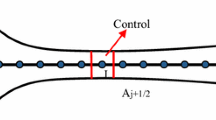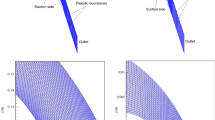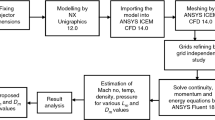Abstract
Steam turbines play a critical role in power generation systems. Therefore, increasing the efficiency of steam turbines is highly desirable, especially in LP stages. One of the suggested techniques to reduce wetness losses in LP stages is the hot steam injection. In the first section of the present study, the effect of 3D turbine blade span length on wet steam flow parameters is investigated. Then, the performance of various arrangements of hot steam injection holes (single slot, in-line no. 1, in-line no. 2, staggered no. 1, and staggered no. 2) is evaluated and compared. The results demonstrated that the in-line no. 1 arrangement is the best design for hot steam injection. In this arrangement, the wetness and condensation loss are reduced by 79% and 44%, respectively, and the kinetic energy loss is less than the other arrangements. However, the kinetic energy is still about 28% lower than in the no-injection case. Ultimately, excessive kinetic energy reduction due to hot steam injection is prevented by decreasing the injection pressure. As the injection pressure is reduced from 160 to 100 kPa, the kinetic energy, wetness, and condensation loss are reduced by 9%, 40%, and 17%, respectively, compared to the no-injection case.


















Similar content being viewed by others
Abbreviations
- A :
-
Area (m2)
- B :
-
Second virial coefficient (m3 kg−1)
- C :
-
Third virial coefficient (m6 kg−2)
- C p :
-
Heat capacity at constant pressure (J kg−1 K−1)
- C v :
-
Heat capacity at constant volume (J kg−1 K−1)
- E :
-
Total energy (J)
- EC:
-
Economic cost ($ h−1)
- H r :
-
HSI ratio (–)
- h :
-
Static enthalpy (J kg−1)
- h lv :
-
Specific enthalpy of evaporation (J kg−1)
- I :
-
Nucleation rate (no. of droplets/m3 s)
- K :
-
Kinetic energy (kg m2 s−3)
- K r :
-
Kinetic energy ratio (–)
- k :
-
Turbulent kinetic energy (m2 s−2)
- k B :
-
Boltzmann constant (–)
- L r :
-
Condensation loss ratio (–)
- l :
-
Length of the nozzle’s divergent section (m)
- M m :
-
Specific molecular mass of water (kg mol−1)
- P :
-
Pressure (Pa)
- Pr:
-
Prandtl number
- q c :
-
Condensation coefficient (–)
- r :
-
Radius (m)
- R :
-
Gas constant (J kg−1 K−1)
- S :
-
Super saturation ratio (–)
- t :
-
Time (s)
- T :
-
Temperature (K)
- u :
-
Flow velocity (m s−1)
- V :
-
Average volume (m3)
- W r :
-
Wetness ratio (–)
- \(\mathrm{HSI}\) :
-
Hot steam injection
- β :
-
Liquid mass fraction (–)
- γ :
-
The ratio of specific heat capacities (–)
- Γ :
-
Mass production rate due to condensation (kg m−3 s−1)
- δ ij :
-
Kronecker delta function
- ε :
-
Turbulent kinetic energy dissipation rate (m2 s3)
- η :
-
Number of droplets per unit volume (m−3)
- θ :
-
Non-isothermal correction factor (–)
- μ :
-
Viscosity (Pa s)
- ρ :
-
Mixture density (kg m−3)
- σ :
-
Liquid surface tension (N m−1)
- τ :
-
Viscous shear stress tensor (Pa)
- d :
-
Droplet
- eff:
-
Effective
- exit:
-
Exit surface
- i, j :
-
Tensor notation
- I :
-
Injection case
- in:
-
Inlet
- l :
-
Liquid phase
- lv :
-
Liquid–vapor
- M :
-
Main case (no injection)
- out:
-
Outlet
- sat:
-
Saturation
- t :
-
Turbulence
- v :
-
Vapor phase
- 0:
-
Stagnation
- \(^{\overline{\,}}\) :
-
Average
- \(^{\widetilde{\, }}\) :
-
Time averaged
- \(^{\acute{\, }}\) :
-
Fluctuation
- *:
-
Critical condition
References
Bakhtar F, Mahpeykar MR, Abbas KK. An investigation of nucleating flows of steam in a cascade of turbine blading-theoretical treatment. J Fluids Eng. 1995;117(1):138–44.
Bakhtar F, Mahpeykar MR. On the performance of a cascade of turbine rotor tip section blading in nucleating steam part 3: theoretical treatment. Proc Inst Mech Eng Part C J Mech Eng Sci. 1997;211(3):195–210.
Bakhtar F, Rassam SY, Zhang G. On the performance of a cascade of turbin rotor tip section blading in wet steam part 4: droplet measurements. Proc Inst Mech Eng Part C J Mech Eng Sci. 1999;213(4):343–53.
Mashmoushy H, Mahpeykar MR, Bakhtar F. Studies of nucleating and wet steam flows in two-dimensional cascades. Proc Inst Mech Eng Part C J Mech Eng Sci. 2004;218(8):843–58.
Dykas S, Wróblewski W. Single- and two-fluid models for steam condensing flow modeling. Int J Multiph Flow. 2011;37(9):1245–53.
Eberle T, Schatz M, Starzmann J, Grübel M, Casey M. Experimental study of the effects of temperature variation on droplet size and wetness fraction in a low-pressure model steam turbine. Proc Inst Mech Eng Part A J Power Energy. 2013;228(1):97–106.
Wang C, Wang L, Zou T, Zhang H. Influences of area ratio and surface roughness on homogeneous condensation in ejector primary nozzle. Energy Convers Manag. 2017;149:168–74.
Yang Y, Walther JH, Yan Y, Wen C. CFD modeling of condensation process of water vapor in supersonic flows. Appl Therm Eng. 2017;115:1357–62.
Zhang G, Zhang S, Zhou Z, Li Y, Wang L, Liu C. Numerical study of condensing flow based on the modified model. Appl Therm Eng. 2017;127:1206–14.
Min D, Kim H, Lee H, Lee C, Kim C. Accurate and efficient computations of phase-changing flows in thermal vapor compressors. Appl Therm Eng. 2018;128:320–34.
Ding H, Li Y, Lakzian E, Wen C, Wang C. Entropy generation and exergy destruction in condensing steam flow through turbine blade with surface roughness. Energy Convers Manag. 2019;196:1089–104.
Hric V, Halama J. On the numerical solution of non-equilibrium condensation of steam in nozzles. Adv Comput Math. 2019;45(4):2147–62.
Salmani F, Mahpeykar MR. Dimensional analysis for estimating wetness terms of condensing steam using dry flow data. J Therm Anal Calorim. 2019;137(6):2121–34.
Wen C, Karvounis N, Walther JH, Yan Y, Feng Y, Yang Y. An efficient approach to separate CO2 using supersonic flows for carbon capture and storage. Appl Energy. 2019;238:311–9.
Yang Y, Zhu X, Yan Y, Ding H, Wen C. Performance of supersonic steam ejectors considering the nonequilibrium condensation phenomenon for efficient energy utilisation. Appl Energy. 2019;242:157–67.
Salmani F, Mahpeykar MR, Rad EA. Estimating heat release due to a phase change of high-pressure condensing steam using the Buckingham Pi theorem. Eur Phys J Plus. 2019;134(1):1–18.
Wen C, Gong L, Ding H, Yang Y. Steam ejector performance considering phase transition for multi-effect distillation with thermal vapour compression (MED-TVC) desalination system. Appl Energy. 2020;279:115831.
Wen C, Karvounis N, Walther JH, Ding H, Yang Y. Non-equilibrium condensation of water vapour in supersonic flows with shock waves. Int J Heat Mass Transf. 2020;149:119109.
Wen C, Ding H, Yang Y. Optimisation study of a supersonic separator considering nonequilibrium condensation behaviour. Energy Convers Manag. 2020;222:113210.
Zhang G, Dykas S, Yang S, Zhang X, Li H, Wang J. Optimization of the primary nozzle based on a modified condensation model in a steam ejector. Appl Therm Eng. 2020;171:115090.
Salmani F, Amiri Rad E, Mahpeykar MR. Investigation effects of roughness in wet steam flow with Buckingham Pi-theorem. J Therm Anal Calorim. 2022;147:3803–13.
Amiri Rad E, Mahpeykar MR, Teymourtash AR. Evaluation of simultaneous effects of inlet stagnation pressure and heat transfer on condensing water-vapor flow in a supersonic Laval nozzle. Sci Iran. 2013;20(1):141–51.
Vatanmakan M, Lakzian E, Mahpeykar MR. Investigating the entropy generation in condensing steam flow in turbine blades with volumetric heating. Energy. 2018;147:701–14.
Hosseini R, Lakzian E. Optimization volumetric heating in condensing steam flow by a novel method. J Therm Anal Calorim. 2019;140(5):2421–33.
Hoseinzade D, Lakzian E, Hashemian A. A blackbox optimization of volumetric heating rate for reducing the wetness of the steam flow through turbine blades. Energy. 2021;220:119751.
Mirhoseini MS, Boroomand M. Multi-objective optimization of hot steam injection variables to control wetness parameters of steam flow within nozzles. Energy. 2017;141:1027–37.
Mirhoseini MS, Boroomand M. Control of wetness fraction and liquid droplet size in wet steam two phase flows with hot steam injection. Meccanica. 2017;53(1–2):193–207.
Aliabadi MAF, Lakzian E, Khazaei I, Jahangiri A. A comprehensive investigation of finding the best location for hot steam injection into the wet steam turbine blade cascade. Energy. 2020;190:116397.
Faghih Aliabadi MA, Jahangiri A, Khazaee I, Lakzian E. Investigating the effect of water nano-droplets injection into the convergent-divergent nozzle inlet on the wet steam flow using entropy generation analysis. Int J Therm Sci. 2020;149:106181.
Dolatabadi AM, Masoumi S, Lakzian E. Optimization variables of the injection of hot-steam into the non-equilibrium condensing flow using TOPSIS method. Int Commun Heat Mass Transf. 2021;129:105674.
Noori Rahim Abadi SMA, Ahmadpour A, Abadi SMNR, Meyer JP. CFD-based shape optimization of steam turbine blade cascade in transonic two phase flows. Appl Therm Eng. 2017;112:1575–89.
Zhang G, Wang L, Zhang S, Li Y, Zhou Z. Effect evaluation of a novel dehumidification structure based on the modified model. Energy Convers Manag. 2018;159:65–75.
Zhang G, Wang F, Wang D, Wu T, Qin X, Jin Z. Numerical study of the dehumidification structure optimization based on the modified model. Energy Convers Manag. 2019;181:159–77.
Wen C, Yang Y, Ding H, Sun C, Yan Y. Wet steam flow and condensation loss in turbine blade cascades. Appl Therm Eng. 2021;189:116748.
Park JS, Lee DH, Rhee D-H, Kang SH, Cho HH. Heat transfer and film cooling effectiveness on the squealer tip of a turbine blade. Energy. 2014;72:331–43.
Satta F, Tanda G. Effect of discrete-hole arrangement on film-cooling effectiveness for the endwall of a turbine blade cascade. Appl Therm Eng. 2015;91:507–14.
Bashir MH, Shiau C-C, Han J-C. Film cooling effectiveness for three-row compound angle hole design on flat plate using PSP technique. Int J Heat Mass Transf. 2017;115:918–29.
Gao W-J, Yue Z-F, Li L, Zhao Z-N, Tong F-J. Numerical simulation on film cooling with compound angle of blade leading edge model for gas turbine. Int J Heat Mass Transf. 2017;115:839–55.
Cheng F-n, Zhang J-z, Chang H-p, Zhang J-y. Investigations of film-cooling effectiveness on the squealer tip with various film-hole configurations in a linear cascade. Int J Heat Mass Transf. 2018;117:344–57.
Farokhipour A, Mansoori Z, Saffar-Avval M, Ahmadi G. Numerical modeling of sand particle erosion in return bends in gasparticle two-phase flow. Sci Iran. 2018;25:3231–42.
Hu P, Cao L, Su J, Li Q, Li Y. Distribution characteristics of salt-out particles in steam turbine stage. Energy. 2020;192:116626.
Zhao A, Guo S, Qi X, Gao S, Sun J. Numerical study on the nano-droplets formation process from superheated steam condensation flow effected by nozzle convergent profile. Int Commun Heat Mass Transf. 2019;104:109–17.
Hill PG. Condensation of water vapour during supersonic expansion in nozzles. J Fluid Mech. 2006;25(3):593–620.
Young JB. Two-dimensional, nonequilibrium, wet-steam calculations for nozzles and turbine cascades. J Turbomach. 1992;114(3):569–79.
Young JB. An equation of state for steam for turbomachinery and other flow calculations. J Eng Gas Turbines Power. 1988;110(1):1–7.
Kawagishi H, Onoda A, Shibukawa N, Niizeki Y. Development of moisture loss models in steam turbines. Heat Transf Asian Res. 2013;42(7):651–64.
Ergunova O, Lizunkov V, Blaginin V, Politsinskaya E, Shaykina OIJIJoEE, and Policy. Formation of the price mechanism for energy resources in Russia and the countries of the European Union. Int J Energy Econ Policy (IJEEP). 2018;8:122–7.
Moore MJ, Walters PT, Crane RI, Davidson BJ. Predicting the fog drop size in wet steam turbines. Wet Steam. 1973;4:101–9.
Author information
Authors and Affiliations
Corresponding author
Additional information
Publisher's Note
Springer Nature remains neutral with regard to jurisdictional claims in published maps and institutional affiliations.
Rights and permissions
About this article
Cite this article
Kafaei, A., Lakzian, E., Ahmadi, G. et al. An investigation of finding the best arrangement of hot steam injection holes in the 3D steam turbine blade cascade. J Therm Anal Calorim 147, 10595–10612 (2022). https://doi.org/10.1007/s10973-022-11242-6
Received:
Accepted:
Published:
Issue Date:
DOI: https://doi.org/10.1007/s10973-022-11242-6




